63110 netter95
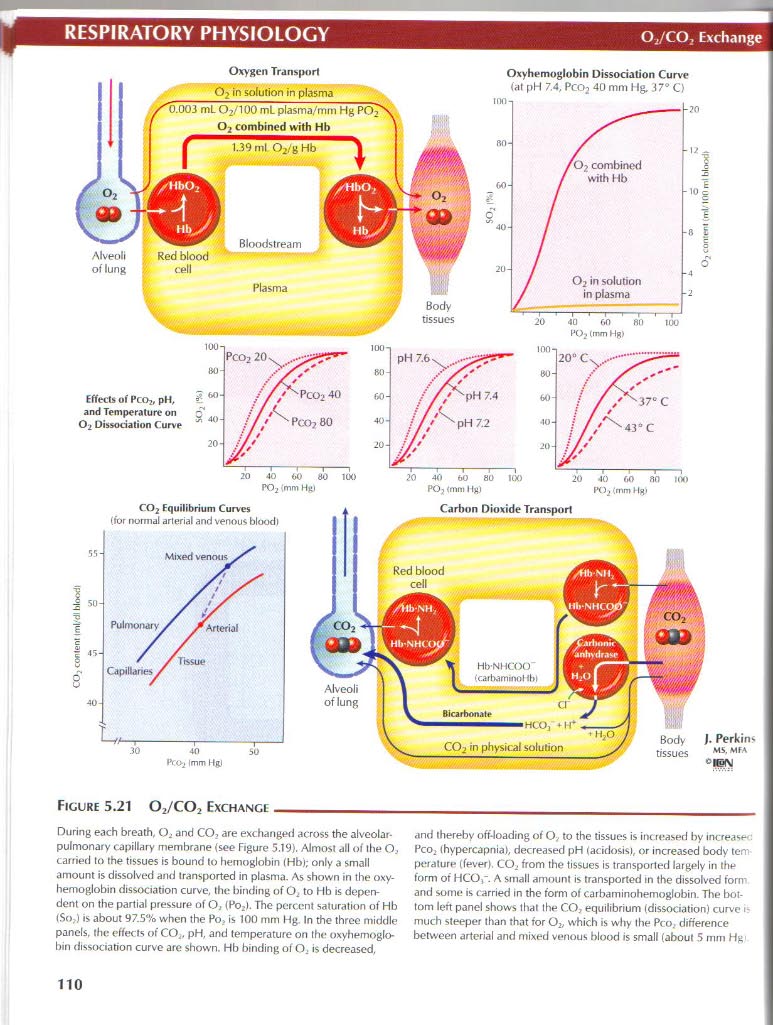
OJCO, Exchange
RESPIRATORY PHYSIOLOGY
Oxygen Transport
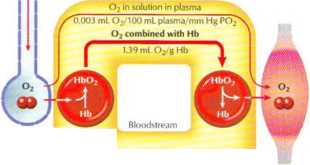
Alveoli Red blood oflung celi
Plasma
8ody
tissues
Oxyhemoglobin Dissociation Curve
(al pH 7.4, Pco2 40 mm l ig, 37° C)
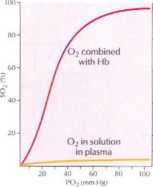

-8 1
Effects of PcOj, pH, and Temperaturę on O2 Dissociation Curve
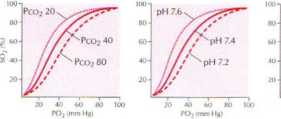
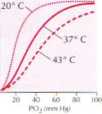
C02 Fquilibrium Curves
(for normal arlerial and venous blood)
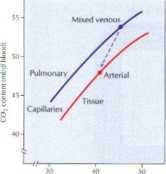
Pro-j imm Hgl
Carbon Dioxide Transport
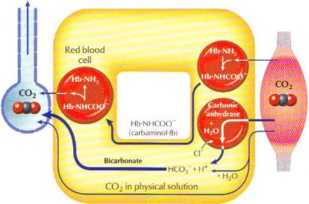
Body J- Perkin-
tissues MS-MrA
cmy
Alveoli of lung
Figurę 5.21 02/C0> Exchange_
During each breath, O, and CO, are exchanged across the alvcolar-pulmonary capillary membranę <see Figurę 5.19). Almost all of ihe O., carried lo ihe tissues is bound to hemoglobin (Hb); only a smali amount is dissolved and iransported in plasma. As shown in the oxy-hemoglobin dissociation curve, the binding of O., to Hb is dependent on the parlial pressure of O, (Po2). The pcrccnt saturation of Hb (So,) is about 97.5% when the Po? is 100 mm Hg. In the three middle panels, the effects of CO,, pH, and temperaturę on Ihe oxyhemoglo-bin dissociation curve are shown. Hb binding of O., is decreased, and ihereby off-loading of O, to the tissues is inereased by inerease-: Pco., ihypercapnia), decreased pH (acidosisi, or inereased body tern perature (fever). CO, from the tissues is transported largely in the form of HCO,-. A smali amount is transported in the dissolved form and somc is carried in the form of carbaminohemoglobin. The bot-tom leń panel shows thal Ihe CO, eąuilibrium (dissociation) curve i-much steeper than that for O,, which is włty ihe Pco, difference between arterial and mixed venous blood is smali (about 5 mm Hg1
110
Wyszukiwarka
Podobne podstrony:
netter93 O, and CO_. ExchangrRESPIRATORY PHYSIOLOGY Figurę 5.19 02 and CO, Exchange As blood flows I
77431 netter112 - Cocicentralion RENAL PHYSIOLOGY WATER, ION, AND UREA EXCHANCE IN PRODUCTION OF HYP
netter106 Glomerular FiltratinnRENAL PHYSIOLOGY Colloid osmotic pressure of plasma (Uln) U
netter113 Urine DilutiorRENAL PHYSIOLOGY h2o Na Cl" h2o 375 —*t- Urea Notę: Figurcs given are e
netter126 Autonomie lnnervationGASTROINTESTINAL PHYSIOLOGY Figurę 7.5 Aijtonomic Innervation The inn
netter127 Autonomie lnnervationGASTROINTESTINAL PHYSIOLOGY m generał sympathetics decrease peristals
netter134 Castric DigestionGASTROINTESTINAL PHYSIOLOGY Figurę 7.12 Gastric Digestiye Function The st
netter58 Bectrocardiogram: ICARDIOYASCULAR PHYSIOLOGY Normal $cqucncc ot Cardiac Depolarization and
netter60 Electrocardiogram: IIICARDIOVASCULAR PHYSIOLOGY Norm.il Sequence of Cardiac Depolarization
netter61 Cardiac CycleCARDIOVASCULAR PHYSIOLOGY Figurę 4.9 Cardiac Cycle The cardiac cycle represent
netter69 CARDIOVASCULAR PHYSIOLOGYCirculation to Special R<-(*ions Brain: blood (Iow normally rem
netter80 Mt% YolumpsRESPIRATORY PHYSIOLOGY Inspiratory reserve volume (IRV) Inspiratory >
netter90 Yenlilalion/PerfusionRESPIRATORY PHYSIOLOGY A. Conditions with Iow ventilation/perfusion ra
więcej podobnych podstron